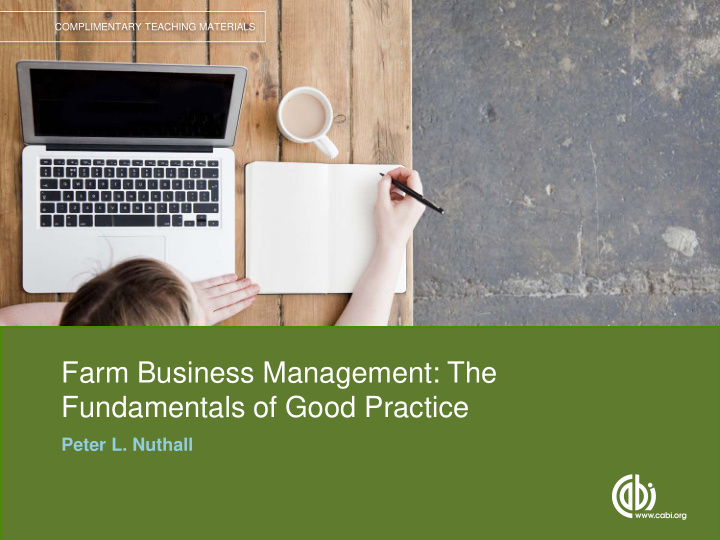



COMPLIMENTARY TEACHING MATERIALS Farm Business Management: The Fundamentals of Good Practice Peter L. Nuthall
Chapter 1 Introduction COMPLIMENTARY TEACHING MATERIALS
LEARNING OBJECTIVES Discover the nature of farm decision problems and learn about the choices that farmers are faced with. Consider how to represent decision problems using symbolic models. Discover and recognize that farmers have varying levels of managerial ability. Learn about the topics the book covers and analytical methods for farm business management. What is the road ahead? COMPLIMENTARY TEACHING MATERIALS
Problem Solving Farm/property management is about problem solving. Each farm is unique. The optimal farm system for each farm will be unique. Risk is a major consideration in problem solving. COMPLIMENTARY TEACHING MATERIALS
Procedures in Problem Solving Formulate problem, create model (can be as simple as a budget), test model, explore solutions. Test solutions and implement. Need at least two possible courses of action to have a decision problem. Need defined objectives to assess alternatives. COMPLIMENTARY TEACHING MATERIALS
Models Use paper representations of farms/properties known as symbolic models (e.g. a farm budget). Simplify where possible, e.g. miss out less important decision variables. Solving models by trial and error (e.g. comparative budgets) through to analytical methods (e.g. using calculus in well-behaved models). COMPLIMENTARY TEACHING MATERIALS
The Manager Varying abilities in the farming community, as shown by survey results. Ability is based on a number of factors, including management style (personality related), intelligence and experience. Important components include observation skills, anticipation skills, risk understanding, and technical and decision theory knowledge. Ability can be improved: work on improving all skills through feedback and other methods. COMPLIMENTARY TEACHING MATERIALS
The Road Ahead There are 17 chapters, divided into five parts: • Part I covers the environment under which farmers make decisions and reviews production economics (decision rules). • Part II covers the financials of primary production including budgeting, risk analysis, investment analysis, and financial records and accounts. • Part III explores the skills a farmer must have, and the psychology of decision making. These include observation, anticipation, management style, objectives and methods of improving skill. • Part IV explores farm systems analysis using surveys, linear programming, systems simulation and dynamic programming, and farm computing. • Part V concludes the book, and examines a range of further human factors including objective complexities. • The Appendices contain farmer tests to explore management style, management aptitude, objectives, locus of control and risk attitude. COMPLIMENTARY TEACHING MATERIALS
Student Guidance, Exercises and Tasks Each chapter highlights its objectives and provides case studies. In addition, each chapter provides exercises and tasks. And on the Internet, further exercises and tasks are available through CABI. COMPLIMENTARY TEACHING MATERIALS
Thank You Name: First Surname Email: email@email.com COMPLIMENTARY TEACHING MATERIALS
Recommend
More recommend